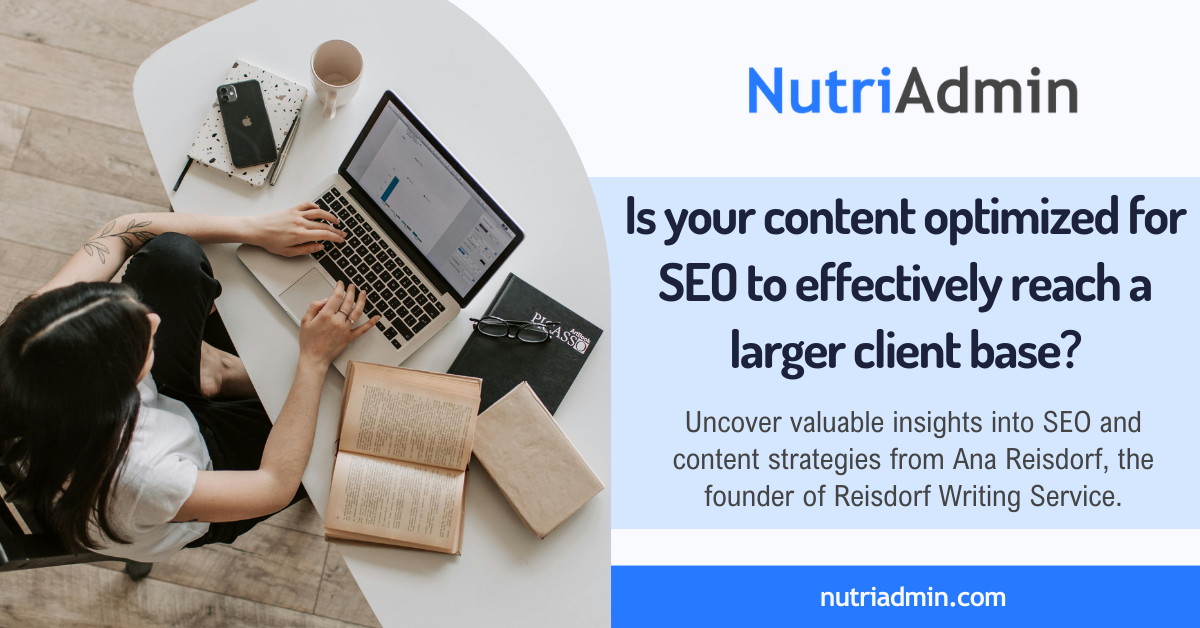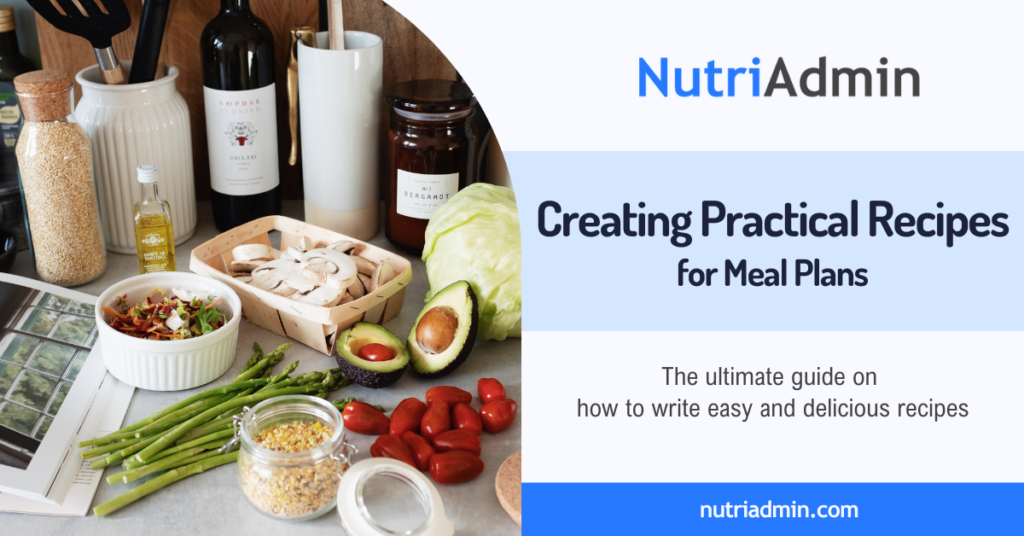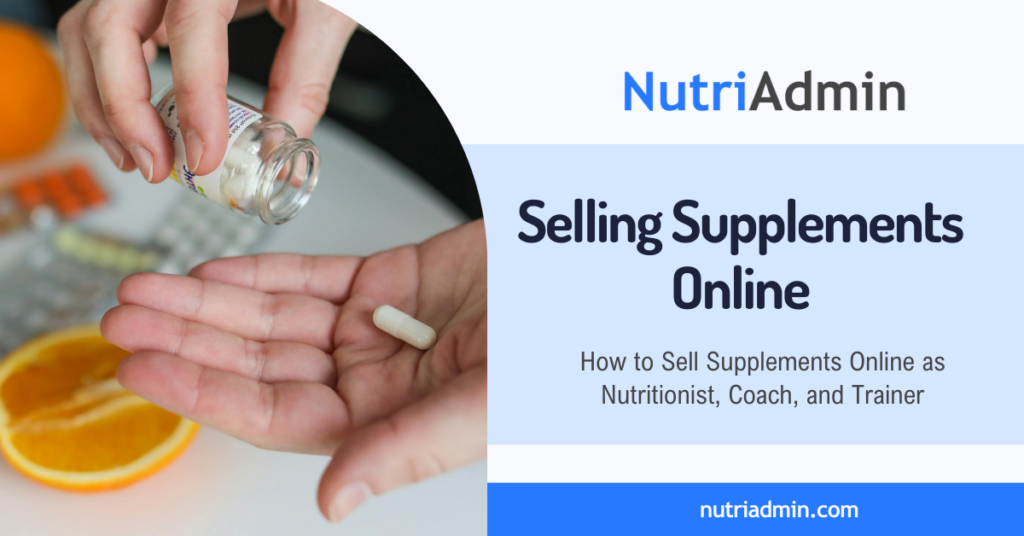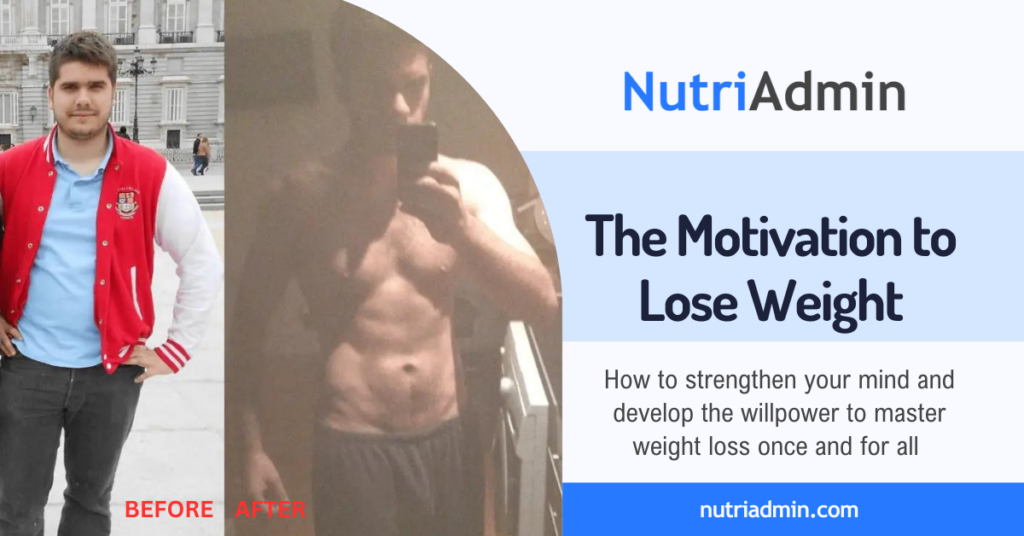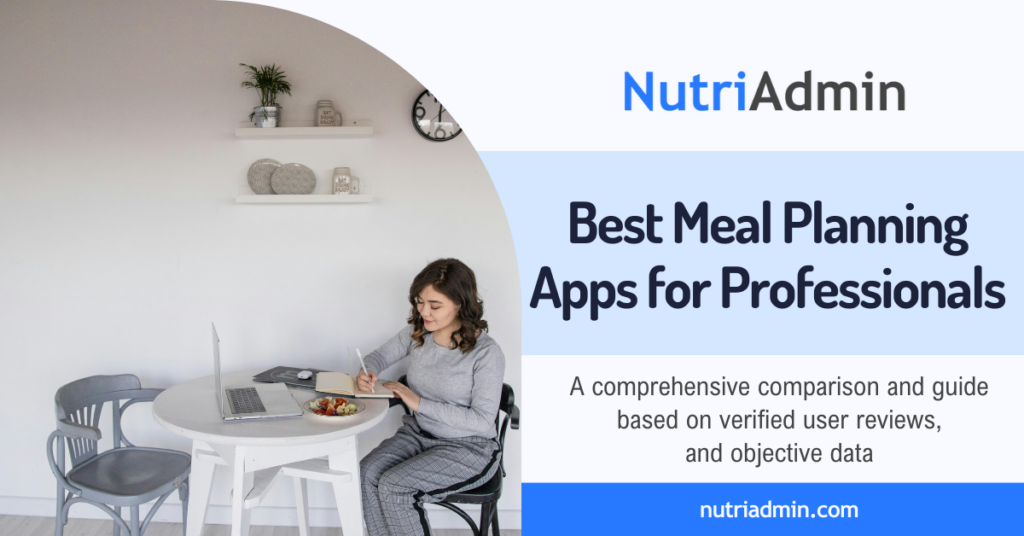Want to attract more customers to your nutrition practice? Lost or curious how SEO and content marketing work for nutritionists, coaches, and personal trainers? Not sure how to rank on Google to get traffic to your wellness site? This article is the definitive guide to answer all these questions and more!
We have teamed up with Ana Reisdorf – an expert on the topic – to cover everything you need to know regarding content strategy and SEO for nutritionists, coaches, personal trainers, and wellness professionals. Moreover, if you read till the end, you can download a practical checklist to ensure your nutrition content articles rank high in search engines.
Ana Reisdorf is the founder of Reisdorf Writing Service, a Health and Nutrition Marketing Agency. She has been running her business for over 6 years. Ana is a Registered Dietitian with over a decade of experience. Ana also holds a Master’s degree in Clinical Nutrition from Central Michigan University.
She started her nutrition and health writing career and now leads a team of health and nutrition content marketing experts. Ana is an expert in SEO and content strategy and she aims to help dietitians, nutritionists, and health brands rank on the first page of Google with evidence-based marketing.
Finally, if you are new to marketing, don’t forget to check our introductory guide on marketing for nutritionists.

- Why is marketing important in nutrition and wellness brands?
- Benefits of Being a Dietitian in This Field
- Learning Marketing and Business Skills
- Advantages of Being a Nutrition Expert
- Potential Brands to Work With
- Effective Content Strategies
- Client Success Story
- Advice for Beginners in Marketing
- Key Tips for Effective Marketing
- How Google Algorithm Works
- Page Speed
- SEO Article Writing Tips from NutriAdmin
- Before Starting
- Using SEO Tools
- How to do Keyword Research
- Write About Specific Services
- Readability
- Adding Relevant Visual Elements
- Don't Skip Heading Numbers
- Alt Text in Images
- Internal and External Links
- Checking Grammar and Spelling
- Adding URL to Google Search Console
- Measuring Your Campaign Performance
- Pitfalls to Avoid
- Free Blog Post Quality Checklist
- Conclusion
- Connect with Ana Reisdorf
- Watch the Interview with Ana on Youtube
- Frequently Asked Questions
Why is marketing important in nutrition and wellness brands?
In any business, nutrition included, marketing is not just a choice—it’s a necessity. It directly contributes to making sales, elevating brand awareness, and fostering a tight-knit community around your brand. By strategically reaching your audience, showcasing your expertise, and building meaningful connections, you’re not just promoting your services but laying the foundation for a successful and thriving business.
Driving Sales
Effective marketing for nutritionists, coaches, and personal trainers goes beyond just sharing information—it’s a powerful tool for driving sales. By strategically promoting services, products, or consultations, dietitians can showcase their expertise in a way that resonates with their target audience. Implementing persuasive and informative content, such as success stories, testimonials, or promotional offers, can encourage potential clients to take the next step and invest in the valuable services offered.
Increasing Brand Awareness
Building a strong online presence is key to increasing brand awareness for dietitians. Consistent and engaging marketing efforts across various platforms help establish a recognizable brand identity. This visibility not only attracts potential clients but also fosters trust and credibility within the industry. As dietitians become more visible, they position themselves as go-to experts, making it more likely for individuals to choose their services over competitors.
Building a Community
Creating a sense of community around a dietitian’s brand can be a game-changer. Through social media engagement, forums, or even hosting webinars, dietitians can connect with their audience on a personal level. Encouraging discussions, sharing valuable insights, and providing a platform for clients to interact with each other not only strengthens the brand’s community but also establishes a supportive environment that enhances the overall client experience.
Benefits of Being a Dietitian in This Field
Similar to Ana’s experience, where traditional nutrition roles, including private practice, didn’t align with her preferences, dietitians can explore a potential career avenue in nutrition and health writing.

This field offers numerous benefits that may resonate with individuals, such as the flexibility to shape their work schedules, the autonomy to work on their terms, unlimited income potential, and an ideal environment for introverts who prefer limited social interactions.
Engaging in nutrition and health writing, especially in a private practice, not only establishes your brand but also enhances your credibility within the field by providing helpful relevant articles to your target market. This career choice empowers dietitians to be recognized, providing a platform for personal and professional growth.
Learning Marketing and Business Skills
While dietitians and nutritionists are undoubtedly experts in nutrition and health, the majority, if not all, are often not equipped with knowledge about marketing and business. Fortunately, with the accessibility of internet resources on this topic, learning these skills independently is not only possible but also highly achievable.
The following are some of the ways Ana learned about Search Engine Optimization (SEO) and content strategy for nutritionists:
- Observe what other people do and how they do it
- Listen to podcasts
- Basic SEO classes – LinkedIn and Hubspot has some free resources
- Experience – It all comes down to having a genuine interest, embracing trial and error, finding what works for you and your niche, and recognizing that it’s an ongoing learning curve.
Advantages of Being a Nutrition Expert
On the internet, there are pages covering all sorts of topics. Some topics, like health, finance, and safety, are crucial for people’s well-being. Google calls these topics “Your Money or Your Life” (YMYL).

Why does Google care so much? Well, it’s because the details about health, money, and safety can really matter to people’s lives and to everyone in society. Google wants to make sure the information you get when you search about these things is top-notch.
When Google rates these pages, they set very high standards because low-quality information could harm people or society. This is where the E-E-A-T (Expertise, Authoritativeness, Trustworthiness) principle comes in, impacting Google’s SEO ranking. Being a dietitian and writing high-quality nutrition and health articles not only helps people but also aligns well with Google’s standards, giving your content an advantage in search rankings.
When it comes to evaluating page quality, Google considers E-E-A-T. Being a dietitian can significantly impact SEO rankings when creating nutrition and health articles by aligning with Google’s E-E-A-T principles.
Experience
As a dietitian, your hands-on experience in the field provides a practical understanding of nutrition and health. Google highly values real-world experience, and this tangible expertise can significantly enhance the perceived value of your content.
Expertise
Your specialized knowledge as a dietitian establishes you as an expert in the field. Demonstrating expertise in your articles, backed by accurate and up-to-date information, contributes to a higher level of trustworthiness and authority.
Authoritativeness
Google values content created by authoritative figures. Being a registered dietitian positions you as a credible source of information in the realm of nutrition and health. This authority enhances the credibility of your articles in the eyes of search engines.
Trustworthiness
Trust is a crucial factor in SEO rankings. As a dietitian, adhering to ethical practices and providing accurate information builds trust with your audience. Google recognizes and rewards content that is trustworthy, contributing to better SEO performance.
Potential Brands to Work With
Drawing from Ana’s expertise in the field, a substantial portion of her client base primarily consists of supplement brands. In addition, she actively collaborates with general health information websites, as well as businesses related to food, baby formula, and various aspects of health and nutrition.
This broad spectrum of collaborations showcases the versatility and extensive reach that dietitians can achieve, making them valuable assets for brands seeking expertise in the nutrition and wellness space.
Effective Content Strategies
The way content creation works is evolving, and it varies based on the amount of content you are creating. Short blogs of around 500 words aren’t really worth it these days. It is better to look into what your competitors are doing and focus on creating more in-depth content. Now, there’s a shift towards using videos, especially with platforms like TikTok. But remember, it still depends on the brand and its audience.
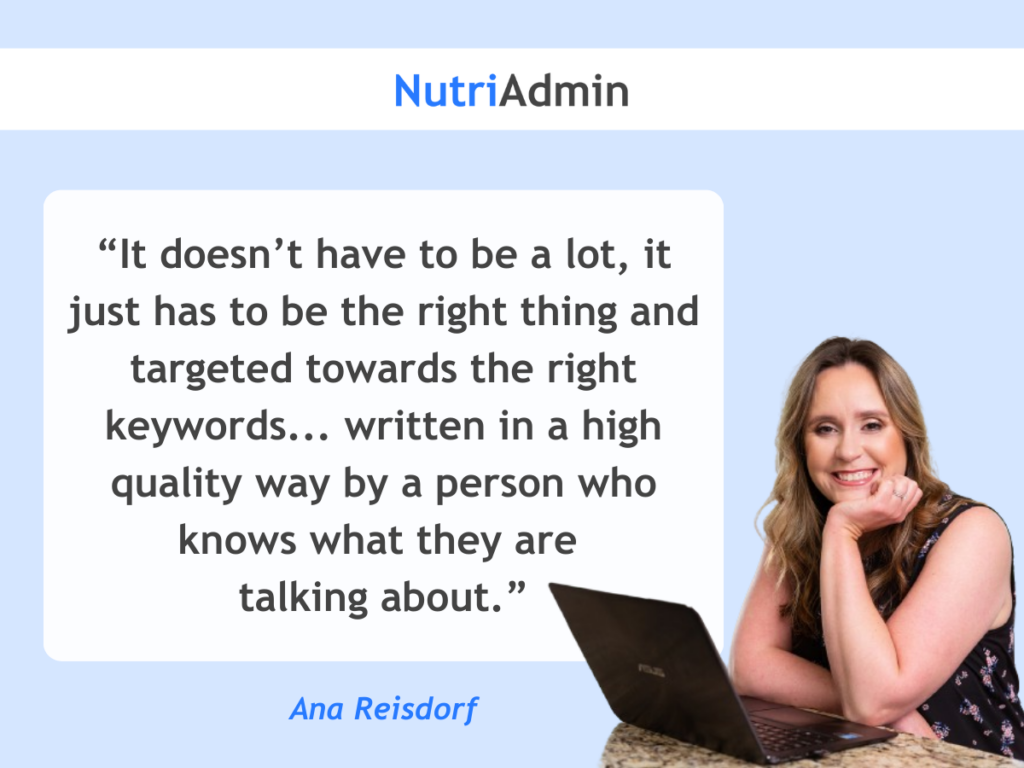
One key thing to note is that the quality of your articles matters a lot. In the health field, short articles don’t get much attention anymore. So, it’s essential to invest time in creating well-researched and comprehensive content to stand out and engage your audience effectively.
In NutriAdmin, our article on becoming a productivity machine ranks at the top on Google search. What sets it apart from other articles is its in-depth nature, spanning about 5,000 words. Similarly, our comprehensive vegan article is steadily climbing ranks, attributed to the value it delivers to readers. We also experimented with publishing a higher volume of shorter articles, but the results were less favorable. This experience shows the importance of prioritizing quality over quantity for successful content performance.
Client Success Story
One of Ana’s clients, specializing in cardiology, experienced remarkable success through their collaboration. Ana, utilizing her expertise in nutrition and health writing, combined with SEO research to curate compelling content.
By publishing two articles monthly and conducting strategic keyword research to identify higher volume keywords, the client witnessed a substantial surge in visibility. They went from about 20 views a month to a whopping 2500 in just three months.
This success shows that the combination of nutrition expertise with effective SEO and content strategies, can make a real impact. Furthermore, this success shows how important it is for nutritionists and wellness brands to invest in these strategies. It helps you reach more people, build credibility, and connect with the right audience in a big way.
Advice for Beginners in Marketing
Starting something new, like exploring a field for the first time, can be tough. The beginning is often the trickiest part. Ana has some helpful advice for when you’re just starting out in marketing. Her insights can be a good guide, making those early steps a bit easier and setting you up for success.
Not Getting Overwhelmed
For nutritionists, coaches, personal trainers, or wellness brands venturing into marketing for the first time, the key advice is to avoid feeling overwhelmed. Instead of trying to do everything at once, focus on taking manageable steps. Recognize that there’s no need to create accounts for Instagram, TikTok, LinkedIn, Facebook, and a website for SEO on day one. Instead, pick one platform that aligns with your goals and gradually build from there. This approach helps prevent the distraction of “shiny objects” and maintains a focused, achievable strategy. By prioritizing one platform initially, you can concentrate your efforts effectively and lay a solid foundation for future expansion.
Choosing One Platform Initially
When starting out, it’s essential to select one marketing platform that resonates with your target audience.You don’t have to pursue every marketing approach out there, such as social media, email marketing, SEO and content, partnerships, etc. Instead, test and find one that works—for example, SEO—you can focus on it and grow it, ignoring the rest.
If you’re a writer aiming to showcase your work, LinkedIn might be the ideal choice. Alternatively, for those seeking to connect with individuals for a private practice, social media platforms like Instagram or TikTok could be more suitable. The key is to align your choice with your specific goals and gradually expand your online presence once you’ve established a foothold.
For instance, NutriAdmin initially experimented with various marketing platforms, especially social media, investing significant time and resources. However, the results were not as expected. It became clear that the most effective way to reach our target audience was through SEO or Google Search.
Once our team recognized this, we shifted our focus and resources toward creating high-quality blog articles and enhancing the NutriAdmin website according to Google’s standards. This strategic change allowed us to channel efforts where they mattered most, ensuring our content was not only valuable but also optimized for better visibility on Google.
While our approach may be effective for us, it’s crucial to recognize that diverse niches and target audiences demand varied platforms. Understanding your audience is key. Consider which marketing platforms they frequently use, begin there, and if results are not as expected, experiment with other marketing platforms. It’s an active process of getting to know your audience and adjusting your strategy based on their preferences and behaviors.
The Importance of a Website
Setting up a high quality website might come with an upfront cost, usually around a thousand dollars, and it can seem a bit intimidating. However, Ana suggests that this initial investment can turn into a valuable long-term asset. When paired with a few well-written blog posts in your niche, this website can become a tool for people to find you through Google and SEO. Ana also mentions that the return on this investment might take about a year.
If you don’t have the resources to pay someone to set up your website yet, you can build one yourself for free. There are WordPress hosting options, such as WPengine that allow you to have an easily customizable website for some amount per month.
What’s great is that a website doesn’t need constant attention like social media does. You don’t have to keep doing things all the time; instead, it steadily pays off over time. It’s like planting a seed that grows into something valuable without needing constant care.
Recognizing the Long-Term Process of SEO
Understanding SEO is like recognizing it’s a long game. It’s not a quick win where you write an article this month and magically find it ranking on page one next month. It’s more of a gradual process, taking about three to six months for your content to gain traction and start attracting significant traffic. SEO involves a patient approach, where the efforts you put in today may take some time, but the payoff in increased visibility and traffic steadily grows over the following months. It’s a strategic investment in the long-term success of your online presence rather than seeking immediate results.
Creating Quality Content
When you invest in quality content, it’s about understanding what people are looking for. It’s not random; it’s strategic. Start by learning a bit about keywords using free resources. Then, focus on creating content that answers what your readers want to know.
For example, if you’re writing about the benefits of apples, get straight to the point instead of telling a long story. Google loves useful content that answers questions. So, when you plan your content, think about what your audience is curious about. Taking this time to plan ensures your content is helpful and directly connects with your readers.
Key Tips for Effective Marketing
Learn how to connect with your audience, improve your content strategy, and get a better understanding of SEO as a nutritionist, coach, personal trainer, or health brand. Ana’s advice focuses on trying to understand potential clients’ interests, utilizing Keyword research tools, and expanding SEO knowledge. Check out Ana’s straightforward tips to help you up your marketing game.
Customer-Centric Approach
Adopting a customer-centric approach means putting your audience at the forefront of your content strategy. Understand their needs, preferences, and questions. This involves delving into what they are searching for, their pain points, and tailoring your content to directly address these aspects. By aligning your content with the interests of your audience, you create a more engaging and valuable experience.
For example, athletes seeking peak fitness have different needs than middle-aged moms looking to lose a few pounds. Know who your target audience is and always write with them in mind. This ensures that your message resonates effectively with the right audience, enhancing the impact of your communication.
Importance of Keyword Research Tools
Keyword research tools play a crucial role in enhancing your content’s visibility. These tools enable you to identify the specific words and phrases your audience is using in their searches. By incorporating these keywords strategically into your content, you increase the likelihood of your material being discovered by your target audience. It’s a crucial aspect of SEO that significantly impacts your content’s effectiveness in reaching and resonating with your customers.
Begin by using free online tools to discover common keywords people use when searching on Google. These tools provide valuable insights into your audience’s interests. As you gain experience and resources, consider transitioning to more reliable paid tools. Investing in advanced tools offers deeper insights, refining your keyword strategy and helping identify resonant phrases with your audience.
Learn Basic SEO
If you’re just starting with SEO, consider enrolling in basic SEO classes to establish a strong foundation. Various platforms, including LinkedIn, Coursera, Udemy, and HubSpot, offer free courses. Additionally, you can explore YouTube or podcasts for insightful content.
These resources comprehensively cover vital topics such as keyword research, on-page optimization, and understanding search engine algorithms. By investing time in learning these concepts, you’ll gain the expertise to navigate SEO complexities. This knowledge empowers you to create standout content, significantly improving your chances of achieving higher rankings in Google search.
Common SEO Terms
- Short Tail Keyword – A short, concise keyword typically consisting of one to three words. Short tail keywords often have high search volumes but may face intense competition. It is essential for capturing broad search traffic.
- Long Tail Keyword – A more extended and specific keyword phrase, usually containing three or more words. It targets niche audiences, providing a higher chance of conversion. Consequently, they contribute to better page ranking for specific queries.
- URL Slug – The readable part of the URL that comes after the domain name. A well-optimized URL slug, containing relevant keywords, improves search engine understanding and user experience, positively impacting SEO.
Example:
https://nutriadmin.com/blog/calorie-deficit-tips-understanding-calories - Domain Authority – A score, typically on a scale from 0 to 100, indicating a website’s credibility and likelihood to rank in search engine results. Higher domain authority enhances the chances of ranking well. It reflects the overall trustworthiness and quality of a website.
- Canonical Tag – An HTML tag that specifies the preferred version of a page when duplicate content exists. Canonical tags help prevent duplicate content issues, guiding search engines to the primary page for indexing and ranking.
- Spam, White Hat/ Black Hat – Spam involves manipulative and unethical practices to deceive search engines. White hat techniques follow ethical guidelines, while black hat techniques violate them. Engaging in white hat practices, such as quality content creation and ethical link-building, improves SEO. Black hat techniques can lead to penalties, negatively impacting rankings.
- Credible Links – In SEO, links from reputable websites act as endorsements, similar to citations in academic papers, boosting a site’s credibility and authority. Quality backlinks are crucial for SEO success. They signal trust and relevance to search engines, positively influencing a site’s ranking.
How Google Algorithm Works
Google gathers various types of data from its search engine, Google Chrome, Android, Gmail, and other tools. The vast amount of data enables Google to identify content that is valuable and relevant to users. Google’s algorithm, the system that determines search rankings, analyzes this data to assess the quality and relevance of content. If your content aligns with what users find helpful and relevant, Google is more likely to boost its ranking in search results. In essence, creating high-quality, relevant content that resonates with users is key to performing well in Google search.
Page Speed
Ensuring your website loads quickly is crucial for a positive user experience and better search engine rankings. If you’re using platforms like WordPress or Wix, be aware that certain templates perform better than others in terms of speed.
To assess your website’s speed, you can use tools like Google PageSpeed Insights. It provides valuable insights and suggestions for improvement.
One significant factor affecting page speed is image optimization. Uploading large, uncompressed images can slow down your site. Some websites automatically optimize images, but if yours doesn’t, you can use free tools like TinyPNG to compress images without sacrificing quality. This can result in faster loading times, contributing to a smoother user experience.
SEO Article Writing Tips from NutriAdmin
Some of you may have discovered NutriAdmin while searching for software for nutritionists, meal planning software, and other related keywords based on the features we offer in Google. At NutriAdmin, we’ve found that SEO is the most effective method for reaching potential clients. Over time, we’ve learned different ways on how to make our content more SEO-friendly and optimized. This way, our content ranks higher in Google, reaching even more potential clients.
We not only work with nutritionists at NutriAdmin. We also offer software for nutrition and wellness coaches and software for personal trainers. Working with these health/fitness professionals over the years has helped us develop knowledge of the field.

Currently, we leverage tools and apply insights gathered from various resources, incorporating tips learned from experienced SEO writers. This continuous learning and application process allows us to stay at the forefront of effective SEO practices, ensuring that our content remains well-optimized and impactful in reaching our target audience.
Before Starting
Similar to Ana’s advice, we actively search for topics that matter to our audience. Once we have the topics in mind, we turn to free online keyword tools to find the perfect keywords. These tools help us identify the exact keywords that have the highest search volume and the least competition. It’s a straightforward approach that ensures we’re using the most effective keywords to reach and resonate with our target audience.
Using SEO Tools
When we write articles, we use Yoast to boost our website’s visibility on search engines. Yoast helps us fine-tune our content and keywords for better SEO. It has useful SEO and Readability analyses, pointing out areas where we can make our articles even better. So, with Yoast, we can create articles that are not only friendly to search engines but also easy for our audience to read and understand. It’s a handy tool for improving the impact of our content online.
How to do Keyword Research
In NutriAdmin, we use WordStream’s free keyword tool to find keywords that have a relatively high search volume and low competition, which are relevant to the topics we want to create content around. All you have to do is type in the topic or initial keywords based on your content, and it will give you 25 keyword variations to choose from.
For example, if you want to create content about gut health, you can type that in, or you can also specify which topics within gut health you want to discuss, like gut issues. You can also try searching the keyword in Google to see what is currently ranking for a term.
Write About Specific Services
As a nutritionist, writing extensive content on specific conditions you address for your clients—such as preparing for a marathon, nutrition during pregnancy, nutrition for teenagers, and managing diabetes—positions you as an expert in the field. This also applies to coaches and personal trainers who also write SEO content in their field. This strategy offers a notable advantage: the more specific the keyword or topic, the higher your ranking, enhancing the relevance of your article or expertise to the person conducting the search, thereby increasing your visibility.
However, a crucial consideration is ensuring that your keywords aren’t excessively narrow, lacking search volume. To address this, utilizing a keyword tool proves important for assessing search volume across various keywords and topics. This approach, commonly known as Long Tail SEO, involves targeting specific, niche keywords or longer phrases in your content.
Readability
Readability significantly influences SEO rankings. Google and other search engines prioritize providing users with valuable and accessible content. If your content is easy to read, visitors are more likely to remain on your page, resulting in lower bounce rates.
Moreover, readability contributes to better engagement and social sharing. Search engines recognize these positive signals and may reward your content with higher rankings. Therefore, focusing on readability by using clear language, proper formatting, and engaging writing style can positively impact your SEO performance.
Adding Relevant Visual Elements
Certain design elements within articles serve dual purposes by enhancing aesthetics and positively impacting SEO. A clean and readable design, including clear fonts and proper spacing, not only makes content visually appealing but also reduces bounce rates, signaling to search engines that the content is valuable.
Engaging elements such as images and infographics can increase user engagement, contributing to longer dwell times, which search engines interpret as relevance. Mobile responsiveness is crucial for SEO, and a responsive design ensures a positive user experience across devices. Optimizing images with descriptive alt text aids search engines in understanding content. Properly structured headers (H1, H2, etc.) organize content for readers and assist search engines in interpreting hierarchy.
Fast-loading pages, achieved through design optimization, improve user experience and are favored by search engines. Integrating social media elements encourages sharing, indirectly influencing SEO through social signals. In essence, strategic design choices contribute to both the visual appeal and SEO effectiveness of articles.
Don’t Skip Heading Numbers
Maintaining a clear and organized structure in your article is crucial for readability. Always adhere to a descending order when using headings. Start with the main title designated as H1, followed by H2 for section headings, and if needed, use H3 within H2 for sub-sections.
Skipping a level, such as placing H4 inside H2 without an H3, can disrupt the flow and hierarchy. While it will not cause major issues, sticking to a descending order ensures a logical and reader-friendly format, making it easier for your audience to navigate and comprehend the content effectively.
Headings offer additional benefits as search engines utilize them for filtering, ordering, and displaying results. Improving your site’s accessibility not only enhances user experience but also makes your page more discoverable.
Alt Text in Images
Alt text, short for alternative text, explains what an image looks like or its purpose on a webpage. Screen readers, used by individuals with visual impairments, read aloud this alt text. This makes you images more accessible to them. It also appears if an image doesn’t load and is indexed by search engines to enhance their understanding of both the image and the page content.
In terms of SEO, adding alt text to images helps Google and other search engines understand and rank your photos in image-based search results, improving their visibility.
Internal and External Links
External links, also called an outbound link, are hyperlinks on a website that lead to pages outside the current domain, connecting to different websites. On the other hand, internal links are hyperlinks that navigate to other pages within the same website, creating a network of interconnected pages.
Here’s how internal and external links help your content:
| Internal Links | External Links |
|---|---|
1. Enhance user experience and site navigation. . | 1. Demonstrate content relevance to other pages for Google. |
| 2. Distribute ranking power among your pages. | 2. Offer additional information and resources to readers. |
| 3. Boost relevance and authority for specific keywords | 3. Build relationships for exposure, traffic, and backlinks. |
Checking Grammar and Spelling
The quality of grammar and spelling in your content holds significance for SEO due to its impact on user experience and overall credibility. When your content is well-written and free of errors, it ensures that visitors can easily comprehend the information, leading to a more positive user experience.
Beyond user satisfaction, proper grammar and spelling contribute to the credibility of your content. Users are more likely to trust information that is presented professionally and without linguistic mistakes. While search engines like Google don’t have specific penalties for grammar and spelling errors, they prioritize content that provides a positive user experience. If users consistently leave a page due to poor language, it can indirectly influence rankings.
Additionally, well-written content tends to be more engaging and shareable, contributing to positive signals that search engines consider when evaluating the relevance and authority of your content.
In NutriAdmin, our typical practice involves utilizing Google Docs to identify and correct spelling and grammar errors. Additionally, we ask another team member to proofread articles before they are published. The collaborative approach of having two sets of eyes ensures a more thorough review, as the input of multiple team members enhances the overall quality of the content. This method is effective for catching errors and maintaining high-quality, error-free articles.
Adding URL to Google Search Console
Adding the URL of a published post to Google Search Console is relevant to SEO because it helps Google discover and index your content faster. By submitting your URL, you’re notifying Google about the new content on your website.
This can lead to quicker inclusion in search results, ensuring that people can find and access your post when relevant queries are made. It’s a proactive step to improve the visibility of your content in search engine results, which is essential for driving organic traffic to your website.
Measuring Your Campaign Performance
Utilizing tools such as Google Analytics, Search Console, or SEranking allows you to actively monitor the number of visits to your website and track the ranking performance of your pages. These tools provide valuable insights into user behavior and the effectiveness of your SEO strategies.
To further engage with your audience, consider integrating your blog posts with the creation of a mailing list. Tools like Drip, ConvertKit, Mailchimp, or Customer.io can help capture reader emails, enabling you to build a dedicated list of subscribers whom you can reach out to over time. This proactive approach enhances your ability to connect with your audience and nurture lasting relationships.
Pitfalls to Avoid
The following are common mistakes you should avoid while creating an SEO optimized content.
Keyword Stuffing
Keyword stuffing is when you use too many keywords on a webpage to try to trick search engines. This used to work however, modern search algorithms are smarter and can spot this tactic. Keyword stuffing is now seen as spam and can result in penalties from Google. Google’s Panda update specifically targeted low-quality content and made keyword stuffing ineffective.
To optimize your webpage for search engines, strategically place your main keyword in key areas like the title, heading (H1), and meta description. However, ensure that your writing flows naturally and doesn’t force the keyword too much, as readability is crucial.
Rather than fixating on keyword frequency metrics, prioritize creating high-quality content that adds value to readers. Additionally, consider incorporating synonyms, variations, and long-tail keywords related to your primary keyword to improve the overall content of your page. This approach aligns with modern search engine algorithms, allowing your content to rank for multiple relevant queries.
Keyword Cannibalization
Keyword cannibalization occurs when multiple pages on a website target the same or very similar keywords. This can lead to confusion for search engines as they try to determine which page is the most relevant for a specific keyword. The issue arises when you have more than one page competing for the same keyword, as search engines may struggle to decide which page to show in search results.
To avoid keyword cannibalization, it’s crucial to have a clear structure on your website, ensuring that each page focuses on a specific topic or keyword. Having multiple pages covering the same topic can lead to a penalty from search engines, as they prefer to provide diverse and relevant results to users. In simple terms, it’s best to organize your content so that each page addresses a unique topic, helping search engines understand and rank your pages more effectively.
If you have multiple pages in your website targeting the same keyword, you may consider either removing the weaker pages, or adding a meta noindex tag. The noindex tag ensures Google won’t index your duplicate page. This can be particularly useful for “news” articles. For example, if you have a main article for “weight loss for busy professionals” and you have just added a short article focused on “we have partnered with this gym to help busy professionals lose weight”, you could consider making the second page noindex. You can also remove pages in Google Search Console. You should research more on this topic on your own as it can be complex and you don’t want to remove content from Google’s index without good reason
Auto-Generated Slugs for URL
Generating auto slugs involves creating URL components from a combination of numbers and letters, often resembling a random string. However, it’s beneficial to include relevant keywords in the slug. This practice enhances the URL’s clarity and SEO, as search engines use it to understand the page’s content. Including keywords in the slug improves the page’s visibility and helps users and search engines comprehend the topic conveyed by the URL.
Plagiarism
Copying and reposting content without providing proper attribution or citation can result in significant consequences from search engines like Google, particularly in terms of plagiarism. Google heavily penalizes instances of plagiarism, which can adversely affect your website’s rankings and overall online reputation.
To mitigate the impact of potential penalties, it is essential to gain a deeper understanding of proper practices when it comes to using or duplicating content. First and foremost, learn about appropriate citation methods. Additionally, understand the rules and guidelines surrounding the reuse of information. By adopting these best practices, you can maintain a positive standing with search engines, uphold ethical standards, and avoid potential setbacks to your website’s visibility and authority.
Moving Domains and Links
If you’re thinking about switching to a new web address, using subdomains, or moving your content to a different site, be cautious. These can seriously hurt your website’s visibility on Google. Before you make any big changes, carefully assess the potential risks because once done, they might be permanent. Understand the details, have a solid plan, and make sure you’re ready for any negative effects on how well your site shows up online.
Getting Links from Spam-Filled Websites
If spam or suspicious websites will link to you, Google will most likely just ignore it and won’t affect your site. However, if you actively try to link your site on these spammy sites, you’ll be penalized. It’s essential to focus on quality links from reputable sources to enhance your website’s credibility and avoid any negative impact on your online presence.
Free Blog Post Quality Checklist
To help ensure that your content is optimized for SEO, we’ve created a checklist guide applying the principles on how to write an article to rank high in Google search.
Conclusion
Utilizing SEO and content strategy can greatly benefit your nutrition or health business. It helps in driving sales, increasing brand awareness, and building a community. For beginners, it’s crucial to avoid feeling overwhelmed by not trying to do everything at once. Selecting one platform initially and experimenting to find what works best for your brand is ideal.
If you choose to focus on SEO, it’s crucial to understand that instant results are not guaranteed. Instead, invest time and effort in learning the basics, selecting relevant keywords that pique your target audience’s curiosity, and producing in-depth, quality content. While an upfront investment in building a quality website may be necessary, concentrating on creating SEO-friendly content can help you gain traction in the long run. This is in contrast to social media, where constant content creation is needed to stay relevant.
In summary, a focused approach to SEO and content strategy can positively impact your nutrition or health business’s marketing efforts, offering lasting benefits over time.
Connect with Ana Reisdorf
It is possible to learn SEO on your own and to get started for free relatively easily. We hope this guide has plenty of actionable tips that can help you get your content ranking in search engines and leading to more customer. However, if you get stuck or need help, it can be invaluable to get advice from an expert. Ana has both a background in nutrition and in SEO copywriting, so she could be the perfect fit if you work in nutrition/wellness. Here are her details in case you want to reach out to her directly.
Facebook group, RDs who write:
https://www.facebook.com/groups/1758105677849876
Linkedin personal:
https://www.linkedin.com/in/ana-reisdorf-ms-rd-33b414/
Linkedin Business:
https://www.linkedin.com/company/reisdorf-writing-services
Instagram: Nutrition_writers:
https://www.instagram.com/nutrition_writers
On the other hand, if you have any questions about anything mentioned in this article specifically, please write down in the comments. This way, we can answer and other readers can benefit from the content too!
Watch the Interview with Ana on Youtube
NutriAdmin had the privilege of interviewing Ana Reisdorf, a seasoned expert in both nutrition and marketing. In this discussion, Ana shared valuable insights about SEO and content strategy. Her expertise is specifically aimed at helping dietitians, nutritionists, coaches, personal trainers, and health brands not just be visible but rank prominently on the first page of Google with evidence-based marketing.
You can watch this episode on Youtube in the link below. Make sure to subscribe to the NutriAdmin channel on Youtube to be notified when new episodes are published.
